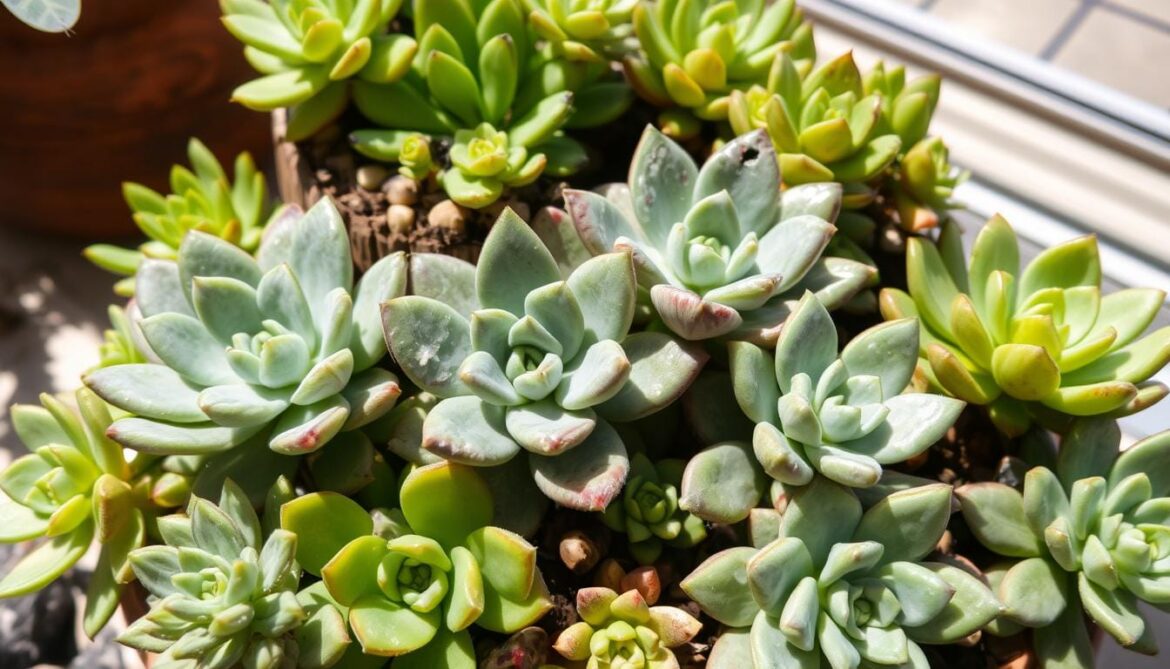Succulents bring joy to our homes and gardens. But, they can get sick if we don’t watch out. Learning about common diseases and how to fix them is key to keeping them healthy.
This guide will teach you how to spot and treat succulent diseases. We’ll cover fungal infections and pests. You’ll learn how to fix your plants and keep them healthy.
Key Takeaways
- Succulents can get sick from fungi, bacteria, and pests.
- Spotting problems early is important for treatment and stopping disease spread.
- Knowing the signs of disease, like color changes and mold, helps you act fast.
- Good care, like right watering and soil, helps your succulents fight off diseases.
- Checking your plants often and using pest control helps keep them healthy.
Understanding Succulent Diseases
Succulent plants are tough, but they can still get sick. Diseases can come from fungi, bacteria, pests, or stress. Knowing about these diseases and catching them early is key to keeping our succulents healthy.
What Are Succulent Diseases?
Succulent diseases are health problems that can affect these plants. Fungi can cause spots and mold, while bacteria can make leaves wilt and rot. Spotting the disease early is crucial to stop it from spreading and harming the plant.
Importance of Early Detection
Spotting diseases early is vital for our succulents’ health. Regular checks can help us catch problems fast. This way, we can treat them quickly, whether it’s using fungicides, getting rid of pests, or changing their environment.
| Common Succulent Pests | Impact on Succulents | Prevention Strategies |
|---|---|---|
| Mealybugs | Affect a significant percentage of succulents, leading to slow withering and potential plant death if left untreated. | Regular inspection, use of insecticidal soaps or neem oil, and maintaining good hygiene practices. |
| Mice | Can severely damage succulents in outdoor environments overnight, posing a significant threat. | Exclusion methods, such as physical barriers or deterrents, and regular monitoring of outdoor succulent environments. |
| Red Spider Mites | Can continue to eat the entire outer layer of succulents if left untreated, potentially causing high mortality rates. | Maintaining proper humidity levels, regular inspection, and use of miticides or insecticidal soaps. |
By understanding succulent diseases and the need for early detection, we can keep our plants healthy. Being watchful and acting fast helps protect our succulents. This way, we can enjoy their beauty for many years.
Common Symptoms of Succulent Diseases
As devoted succulent enthusiasts, we must stay vigilant in identifying the common symptoms of succulent problems. This ensures the health and longevity of our beloved plants. From discoloration to wilting and mold, recognizing these signs can help us provide the necessary care and treatment.
Identifying Leaf Discoloration
One of the first indicators of a succulent disease is leaf discoloration. Whether it’s yellowing, browning, or even bleaching, changes in leaf color can signal an underlying issue. Leaf discoloration can be caused by a variety of factors, including overwatering, nutrient deficiencies, or even sun exposure.
Recognizing Wilting or Shriveling
Another common symptom of succulent diseases is wilting or shriveling of the leaves and stems. This can be a sign of underwatering, pest infestations, or even root rot. Prompt attention to these visual cues can help us determine the appropriate course of action to revive our succulents.
Spotting Mold or Mildew
The presence of mold or mildew on succulent leaves and stems is a clear indicator of a fungal or bacterial infection. White, powdery mildew on echeverias and other succulents can be particularly problematic, requiring swift intervention to prevent the spread of the disease.
By staying attuned to these common symptoms of succulent problems, we can take proactive steps to address any issues. Regularly inspecting our plants and responding promptly to any changes can go a long way in ensuring their long-term success.
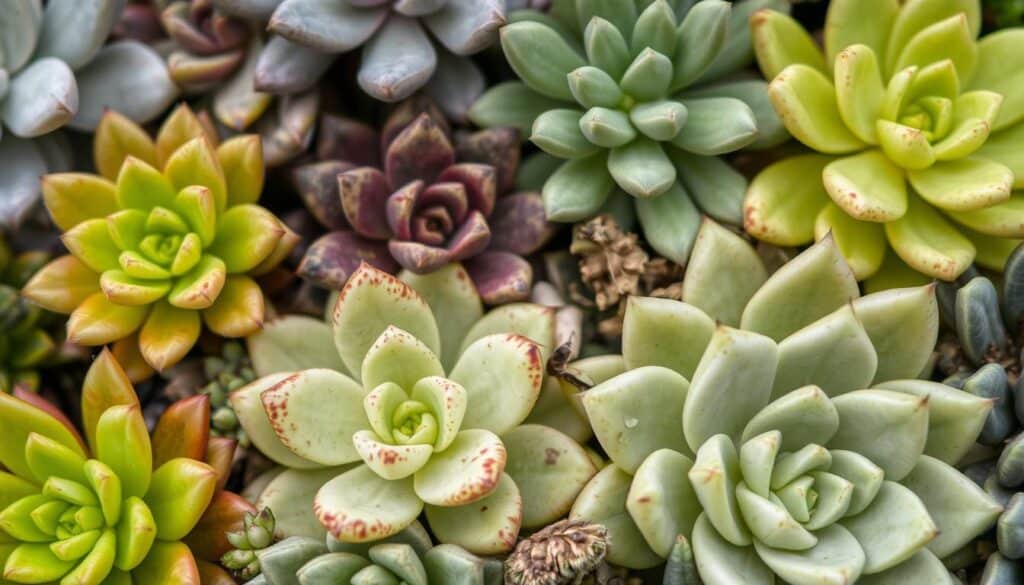
Fungal Infections
Fungal diseases are a big worry for succulent lovers. They can show up as white mildew or worse, harming our plants. It’s important to know the signs, causes, and treatments to keep our succulents healthy.
Common Fungal Pathogens
Succulents face many fungal diseases. These include Cactus Anthracnose, Charcoal Spot, and more. These fungi can cause discoloration and even kill our plants.
Signs of Fungal Infections
Spotting fungal infections early is key. Look for white growth, black spots, and shrunken seedlings. Catching these signs early can help save our plants.
Treatment Options for Fungal Issues
There are ways to fight fungal infections. Removing sick plants and using fungicides can help. Keeping soil dry and well-drained also helps prevent problems.
| Fungal Disease | Symptoms | Treatment Options |
|---|---|---|
| Powdery Mildew | White powder on leaves, scab-like lesions | Baking soda spray, neem oil, copper-based fungicides |
| Botrytis Cinerea (Grey Mold) | Circular spots on leaves, particularly on aloe plants | Dishwashing soap solution, fungicides |
| Leaf Spots | Fungal spots that grow larger and become blotchy | Baking soda solution, commercial fungicides |
| Fusarium Wilt | Yellow, wilting plants due to soil-borne fungus | Removal of affected plants, soil treatment |
Knowing about fungal diseases helps us protect our succulents. By staying alert and treating problems quickly, we can keep our plants healthy and beautiful.
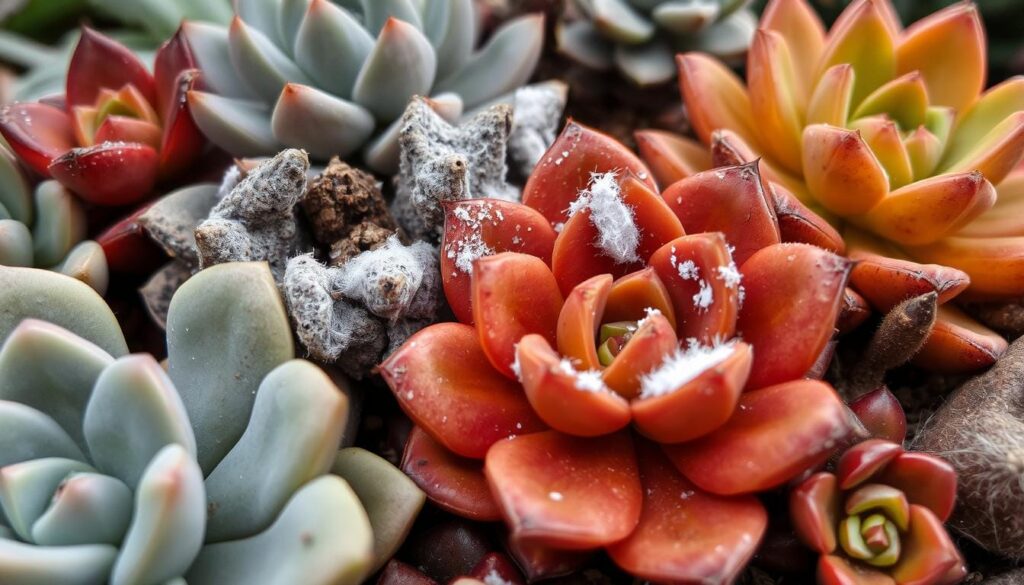
Bacterial Infections
Succulent plants are usually tough, but they can get sick from bacteria. These diseases can make plants wilt, change color, and even die fast. A big problem is bacterial wilt.
Overview of Bacterial Diseases
Bacteria can get into succulents through cuts, damage, or natural openings. When it’s warm and wet, and you water too much, bacteria grow fast. Succulents’ water-rich tissues decay quickly when bacteria attack.
Identifying Bacterial Wilt
Bacterial wilt makes plants wilt fast, turn color, and feel mushy. The bacteria eat away at the plant’s cells, making it soft and weak. Once it starts, it can spread quickly through the plant’s tissues.
Effective Treatments for Bacterial Infections
- Quickly remove and throw away any sick parts to stop the disease from spreading.
- Make sure the soil drains well and don’t water too much to keep bacteria away.
- Use copper-based fungicides to fight the infection.
- Keep things clean by sterilizing tools and disinfecting surfaces to avoid spreading bacteria.
Dealing with bacterial infections in succulents is tough, but catching it early and taking action helps. Knowing the signs and using the right treatments can keep your succulents healthy and looking great.
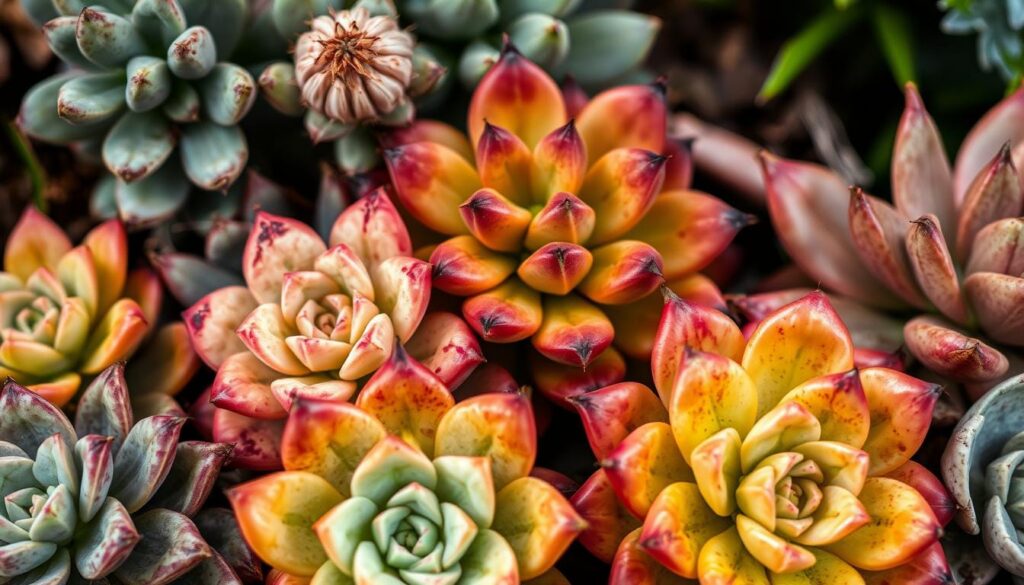
Pest-Related Diseases
Succulent plants can get sick from pests just like any other plant. Pests like mealybugs, scale insects, red spider mites, and snails can harm them. Knowing how to spot and treat these pests helps keep our plants healthy and looking good.
Common Pests Affecting Succulents
- Mealybugs: These tiny insects suck the sap from plants, making them look fuzzy or frosted.
- Scale insects: With over 8,000 types, some are called “armored scale.” They can spread fast, covering the plant.
- Red spider mites: These mites make webs on plants, causing dry, brown spots on new growth.
- Snails and slugs: These leave slime trails on plants as they eat the soft new growth.
- Moth caterpillars: They eat succulents and cacti, often hiding their eggs in safe spots.
Signs of Pest Infestation
Spotting pests early is key to fixing the problem fast. Look for pests, webs, and damage to leaves or stems. These signs mean your plants might be getting sick.
How to Treat Pest-Related Issues
Dealing with pests needs a few steps. You might need to remove pests by hand, use insecticidal soaps, or neem oil. Sometimes, you’ll need to use specific pesticides. Keeping sick plants separate and keeping your growing area clean helps too. Quick and thorough action keeps your succulents healthy and strong.
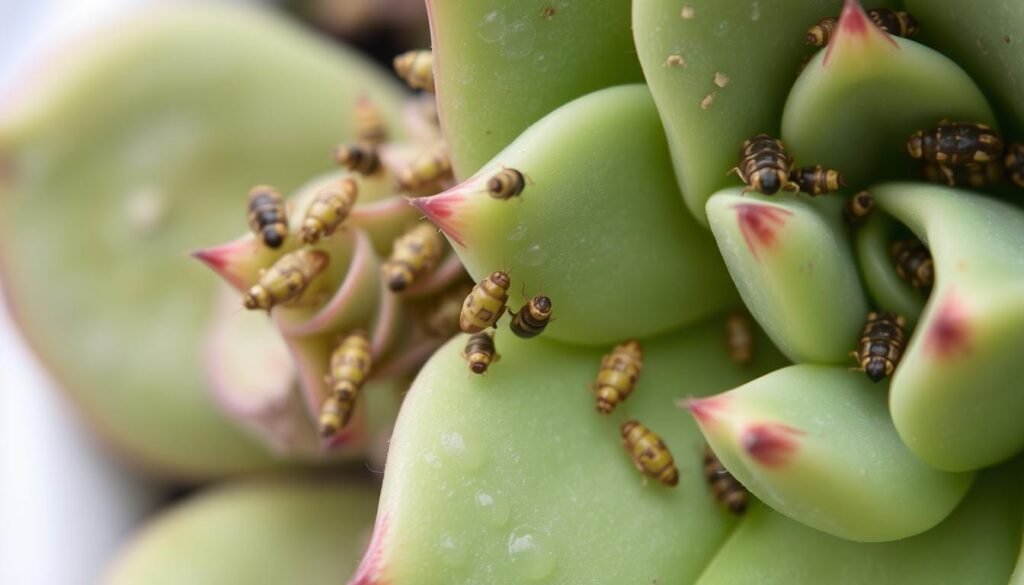
Root Rot
Succulent lovers know these plants are tough against pests and diseases. But, root rot is a big problem. It can harm our plants if we don’t watch out. Knowing how to prevent root rot is key to keeping our plants healthy.
Causes of Root Rot in Succulents
Root rot mainly happens because of too much water and poor drainage. When the soil is always wet, fungi grow, harming the roots. Also, soil that’s too dense can block oxygen, leading to root rot.
Recognizing the Symptoms of Root Rot
Spotting root rot early is important. Look for these signs:
- Yellowing or wilting leaves
- Mushy, discolored stems
- A foul, rotten smell from the soil
- Stunted growth or a lack of energy in the plant
Prevention Strategies for Combating Root Rot
To avoid root rot, take these steps:
- Choose potting soil that drains well.
- Plant in pots with holes to prevent water from pooling.
- Water only when the soil is dry, and don’t overdo it.
- Keep plants well-ventilated to prevent moisture buildup.
- Check your plants often for root rot and fix problems quickly.
By being proactive, we can protect our succulents from root rot. Remember, prevention is the best way to keep our plants healthy and strong.
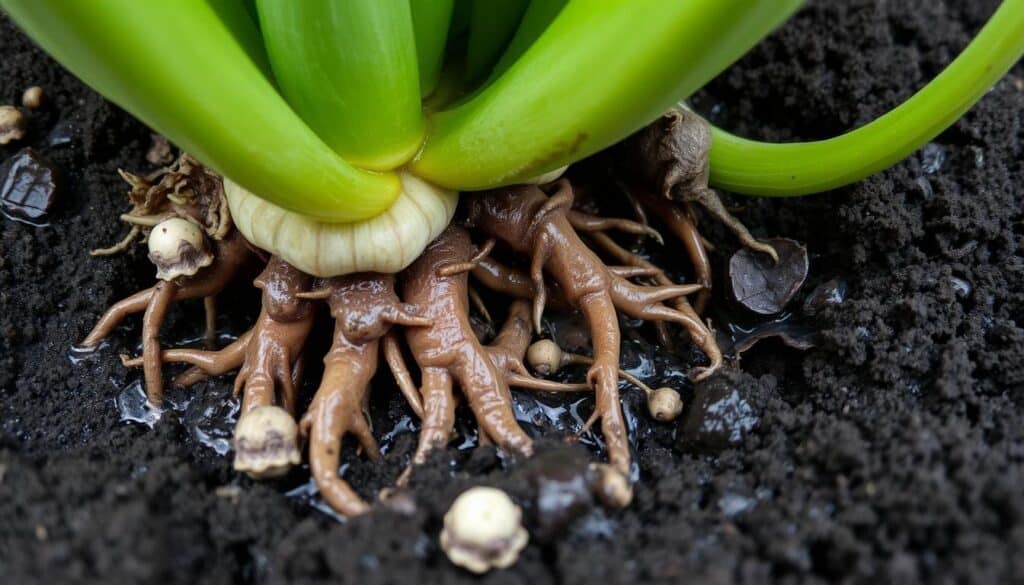
“The key to success in managing succulent diseases is early detection and prompt action. With the right care and attention, we can ensure our succulents remain vibrant and disease-free.”
Sunburn and Environmental Stress
Succulents are tough, but they can still face environmental stress like sunburn. Knowing how to spot and handle these problems is key to keeping our succulents healthy and bright.
Identifying Sunburn in Succulents
Sunburn on succulents shows up as brown or tan spots on leaves, especially after sudden bright light. This can happen when a succulent moves from shade to full sun. Plants in greenhouses or low light are especially at risk when moved to harsh outdoor light.
Signs of Environmental Stress
Succulents can also show signs of stress like color changes, wilting, or slow growth. These signs can come from things like temperature changes, wrong watering, or not enough light. Watching your succulents closely can help you catch and fix any stress they’re under.
How to Manage Environmental Factors
To avoid and deal with sunburn and stress in succulents, it’s vital to slowly get them used to new light, provide shade when needed, and keep care routines steady. This might include:
- Slowly introducing plants to more sunlight over weeks to help them adjust
- Using shade cloths, umbrellas, or other things to block direct, strong sun
- Watering right, as too much or too little water can stress them out
- Checking soil moisture and adjusting water times based on the environment
- Knowing the special needs of each succulent species and giving them the right care
By watching for sunburn and stress signs and taking steps to manage them, we can help our succulents stay healthy and vibrant.
Most succulents can get better from sunburn and stress, but the damaged parts might stay scarred. By understanding and tackling these common issues, we can make sure our succulent gardens do well for a long time.
Soil Quality and Succulent Health
Soil quality is key for growing healthy succulents. These plants need well-draining soil to avoid root rot and disease. Knowing the right soil mix helps our succulents thrive.
Importance of Draining Soil
Draining soil is crucial for succulents. They can easily get root rot from too much water. A good soil mix drains water fast, keeping roots healthy.
Best Soil Types for Succulents
The best soil for succulents is coarse and drains well. Mix coarse sand, perlite, and cactus potting soil for the best results. This mix helps with drainage and gives the nutrients they need.
How Soil Quality Affects Disease Resistance
Good soil helps succulents fight off diseases and pests. Poor soil makes them more vulnerable. Keeping the soil healthy boosts their defenses against succulent problems.
It’s important to check and refresh the soil in succulent pots often. The right balance of drainage, nutrients, and structure supports their health and succulent propagation.
| Soil Component | Purpose | Recommended Ratio |
|---|---|---|
| Coarse Sand | Improves Drainage | 30-50% |
| Perlite | Enhances Aeration | 20-30% |
| Cactus/Succulent Potting Soil | Provides Nutrients | 20-50% |
“Healthy soil is the foundation for healthy, thriving succulents. Investing in the right soil mix is one of the most important steps in succulent care.”
Seasonal Considerations
As the seasons change, we must be mindful of how weather patterns can impact the health and wellbeing of our succulent plants. Understanding the seasonal factors that influence succulent diseases and pests is crucial for providing the best possible care throughout the year.
How Weather Affects Succulent Diseases
Cold, damp conditions commonly experienced during the winter months can increase the risk of fungal and bacterial diseases in succulents. Conversely, the hot, dry weather of summer can lead to sunburn, dehydration, and other environmental stresses that make plants more susceptible to problems.
Seasonal Disease Risk Factors
- Fungal and bacterial infections are more prevalent in cool, moist environments.
- Extreme heat and direct sunlight can cause sunburn and sun scald in succulents.
- Dry air from indoor heating systems during winter can dehydrate succulents.
- Pests like mealybugs and spider mites thrive in warm, dry conditions.
Preparing Succulents for Seasonal Changes
To keep our succulents healthy and thriving throughout the year, we must adapt our care routines to match the changing seasons. This includes adjusting watering schedules, providing appropriate protection from temperature extremes, and closely monitoring for seasonal pests and diseases.
By staying attuned to the unique challenges posed by different seasons, we can ensure our succulent collection remains vibrant and disease-free all year round. With a little seasonal preparation and proactive maintenance, we can help our beloved plants weather the changing conditions with ease.
Maintaining Succulent Health
Caring for succulents is all about finding the right balance. It’s about regular maintenance, keeping things clean, and watching them closely. By doing these things, we can help our succulents grow strong and avoid common problems.
Regular Care Tips
Watering them right, giving them enough light, and keeping them groomed are key. Make sure to water them just enough, not too much or too little. They need lots of bright sunlight. Also, trim off any dead or damaged parts to encourage new growth.
Importance of Hygiene and Cleanliness
Keeping things clean is crucial to stop diseases and pests. Always use clean tools when handling your succulents. Remove any dead plant parts from the soil or around the plants. A clean and well-ventilated growing area can also help prevent problems.
Monitoring for Early Disease Signs
Regular checks on your succulents can help spot issues early. Look for any unusual color changes, growth patterns, or pests. Catching problems early means you can act fast and stop them from spreading.
By following these simple tips, we can keep our succulents healthy and lively. Paying attention to their needs and addressing any issues quickly will help them stay beautiful and long-lasting.
Common Preventative Measures
Keeping our succulents healthy means we need to take care and watch out for diseases. By following a few simple steps, we can keep our plants happy and healthy for a long time.
Watering Best Practices
Watering right is key for succulents. We should water the soil, not the leaves, and let it dry before watering again. Too much water can harm our plants, so we need to be careful and adjust our watering based on the plant’s needs.
Using Pest Control Methods
Protecting our succulents from pests is important. We can use natural pest control like neem oil to fight pests like mealybugs and spider mites. Keeping our growing area clean and isolating sick plants helps stop pests from spreading.
Regular Inspections and Care
Watching our plants closely and caring for them is crucial. We should check for signs of disease or stress like color changes or mold. Giving our succulents the right succulent care helps them stay strong and healthy.
| Common Succulent Pests | Symptoms | Treatment |
|---|---|---|
| Mealybugs | White, cottony masses on leaves and stems | Isolate affected plants, use alcohol sprays |
| Red Spider Mites | Fine webbing, discolored leaves | Quarantine plants, apply acaricide treatments |
| Scale Insects | Bumpy, hard scale-like structures on stems | Remove manually, use insecticidal soaps |
By following these succulent propagation tips, we can grow beautiful and healthy succulent gardens. This way, we can keep our plants safe from diseases and pests.
When to Seek Professional Help
We all love our succulents and want to care for them the best way. But sometimes, we can’t fix problems on our own. That’s when it’s time to get help from a pro to keep our plants healthy.
Signs You Need Expert Assistance
Look out for signs like fast plant decline, widespread infections, or problems that keep coming back. If you see these, it’s time to find a succulent expert near you. Here are some signs you might need a pro:
- Sudden or unexplained wilting, discoloration, or abnormal growth patterns in your succulents
- Persistent fungal or bacterial infections that don’t respond to home remedies
- Severe pest infestations, such as widespread mealybug outbreaks, that are difficult to control
- Recurring issues that you’ve been unable to resolve on your own
Finding a Local Succulent Specialist
Finding a succulent expert near you can be a big help. Look for local gardening clubs, nurseries, or university extension services. They can connect you with pros who know how to fix succulent problems.
Importance of Professional Diagnosis
It’s tempting to try to figure out what’s wrong with your succulents yourself. But a pro can give you a better plan. They can find the real cause of the problem and tell you how to fix it. This saves you time, money, and the sadness of watching your plants get worse.
Being proactive and getting help when you need it is key to keeping your succulents healthy. Don’t be afraid to ask for expert advice. Your succulents will appreciate it!
Conclusion: Protecting Our Succulents from Diseases
Keeping our succulents healthy means knowing about common diseases and pests. We also need to watch out for environmental factors. By being careful and taking action early, we can keep our succulents thriving and beautiful.
Summarizing Key Points
We’ve looked at diseases and problems that can harm succulents, like fungal infections and pests. We’ve also talked about the importance of watering right, managing soil, and checking plants often. These steps help keep our succulents strong and healthy.
Encouragement for Proactive Care
Protecting our succulents from diseases needs us to be proactive. This means regular care, acting fast when we see problems, and getting help when needed. By following these steps, we can make sure our succulents stay healthy and add beauty to our homes. Let’s keep caring for these amazing plants that can live in many different places.
